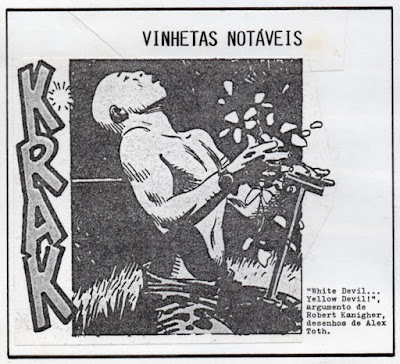Robert Kanigher (w), Alex Toth (a), "White Devil ... Yellow Devil!," Star Spangled War Stories # 164, September 1972. As republished (in b&w) in Nemo # 5, November 1990 (scanned from the magazine mock-up).
This post could also be titled: White Flowers... Red Flowers.
I started writing about comics more than 25 years ago in the so-called fanzines Nuxcuro and Nemo (I don't like the term because I'm no fanatic, of course). That said, Manuel Caldas' amateur magazine Nemo was first published in 1986. I came on board in # 4 of the second series (August 1990).
So, as you can see above, very early (in the next issue, really) Manuel Caldas accepted my suggestion to include a "Vinhetas Notáveis" [remarkable panels] section. What he doesn't know to this day, because I never told him, is that the above was not the remarkable panel that I intended. The real one is shown below:
"White Devil ... Yellow Devil!": I don't know who the colorist was? The Grand Comics Database doesn't help. Neither does Alex Toth.
This remarkable story was republished in Sgt. Rock Special # 8 (June 1990). This means that it was fresh on my mind and it impressed me enough to ask Manuel to open "our" brand new remarkable panels section with one of its panels. Below: Greg Theakston's colors for the same panel:
"White Devil ... Yellow Devil!" as republished in Sgt. Rock Special # 8, June 1990.
The dirt was colored differently.
According to what I call my Nelson Goodman theory of comics fakes recoloring should be banned. Below we can see the first page of the story as originally published:
Robert Kanigher (w), Alex Toth (a), "White Devil ... Yellow Devil!," Star Spangled War Stories # 164, September 1972. The writer was the star of the show.
Anyway, let's see what Alex Toth said about it:
Caught here.
Now, Greg Theakston's colors (wrongly called Theakson):
Robert Kanigher (w), Alex Toth (a), Greg Theakston (c), "White Devil ... Yellow Devil!" as republished in Sgt. Rock Special # 8, June 1990.
There are few issues in the area of film preservation that arouse more anger than the issue of colorization. That is because it is an issue involving taste, and, to put it bluntly, anyone who can accept the idea of the colorization of black and white films has bad taste.I wholeheartedly agree, but I don't think that this is just a matter of taste. It's also a matter of a legitimate historical artifact vs. a fake. It's as if someone painted something over a Rembrandt or if someone rebuilt some part of St. Peter in Rome in some modern style. In the end, though, this is also a matter of taste because bad taste favors what's fake and flashy over what's authentic.
Why did (and does) the comics industry and comics readers accept such a thing? Because, you see, not all comics creators were born equal. There's a hierarchy that mostly goes like this: 1) the drawer; 2) the writer; 3) the editor; 4) the inker; 5) the colorist; 6) the letterer. As you can see above the header of "White Devil ... Yellow Devil!" was erased from the republished version. This happened, methinks, because it gave the writer too much of a star status (which is too much for a # 2). This means that colors can be changed, but changing some master's drawings isn't easily accepted by readers (or should I say, watchers?).
But let's go back to the first page of "White Devil ... Yellow Devil!"... Among other minute differences Greg Theakston corrected the anonymous colorist's, according to Alex Toth, mistake: the white flowers at the end were colored red at the beginning. I would say that this (the correction, I mean) shouldn't have been done and yet...
Greg Theakston's recoloring in this story is quite good and in many ways quite faithful to the original color. There are hundreds or thousands of horrible recoloring jobs out there (mainly using the worst nightmare of comics coloring: computer generated gradients that turn every surface into pristine plastic). So, I would say that this is a really bad choice to attack fake comics. And yet, I chose it for a purpose: since it is a borderline case between what should (only the original material should be reproduced) and shouldn't be done, I'm inclined to agree that correcting a blatant mistake is acceptable. On second thought the democracy of comics creators tells us that the original colorist has as much right to the integrity of his or her work as everybody else (the colorist was usually a woman, which is an additional reason, in the boys club that is the comics industry, to disrespect colors). I'm not even sure if we can call the red flowers a mistake. Alex Toth didn't own the story. He certainly didn't own the colors, so, if the colorist chose to color the flowers red on page one who is he to say that it was a mistake? If Sheldon Mayer, the editor, said nothing, the colors on the first page were always meant to be red, the color of blood, period. (Kindness is what kills both "devils" and we can metonymically link kindness to flowers.)
In the end the question is: who created this comic? Is Greg Theakston one of the creators? The answer is obviously and rotundly, no, he isn't.










